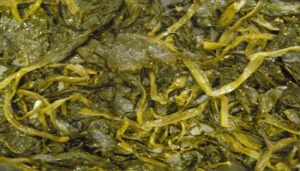Gundruk is particularly popular among Nepali community and the production is carried out at the household level. Gundruk is obtained by fermenting and drying leafy vegetables such as Rayo sag (Brasicca rapa spp.campestris variety cuneifolia), Toriko Sag (leaves of mustard), Mulako Sag (radish leaf) and Banda kopi (cauliflower) to produce a sour brownish black product.
It is served as a side dish with the main meal and is also used as an appetiser and can be made into a soup. Gundruk is an important source of minerals particularly during the off-season in rural areas when the diet consists of mostly starchy tubers and maize which tend to be low in minerals.
Raw material preparation
In the months of October and November, during the harvest of the first broad mustard, radish, spinach and cauliflower leaves, large quantities of leaves accumulate – much more than can be consumed fresh.
Processing
These leaves are allowed to wilt for one or two days and then shredded with a knife or sickle. The shredded leaves are tightly packed in an earthenware pot and warm water at about 30° is added to cover all the leaves. The pot is then kept in a warm place. After five to seven days, a mild acidic taste indicates the end of fermentation and the gundruk is removed and dried, traditionally by the sun. The ambient temperature at the time of fermentation should be about 18°C.
Pediococcus and Lactobacillus species are the predominant micro-organisms during gundruk fermentation. During fermentation, the pH drops slowly to a final value of 4.0 and the amount of acid (as lactic) increases to about 1% on the sixth day. It has been found that a disadvantage with the traditional process of gundruk fermentation is the loss of 90% of the carotenoids, which help to produce vitamin A, probably during sun-drying. Improved methods of drying might reduce the vitamin loss. Once processed, the dried gundruk can be kept in airtight containers for several months.
Preparation
Gundruk ko jhol (soup)
Serves 6 to 8
Gundruk/Sinki 50 g
Onion 1 chopped
Tomato 1 chopped
Dry red chili 2 pods
Turmeric powder 1/2 Tablespoon
Salt 1 Teaspoon
Method: Soak Gundruk/Sinki in water for 10 min. Heat oil and fry chopped onions, tomatoes, chilies. Drain up soaked Gundruk/Sinki and fry, add turmeric powder and salt, and put 2 cups of water. Boil for 10 min, and serve hot with cooked rice.
Gundruk ko achar (pickle)
Serves 6
Gundruk 50 g
Onion 1 chopped
Green chilies 3 chopped
Oil 1 Tablespoon
Salt 1 Teaspoon
Method: Mix all ingredients, and serve as achar (pickle) along with cooked rice

[…] Gundruk […]
my best food iz gundruk n sinki i like it so much that iz esy food
lovely recipes i love the gundruk recipe , i was looking for gundruk ra bhatmas to recipe i could not find ….
wow…i was missing gundruk here in france aswell..i gave a try out with the leaves of cauliflower and it worked wonders.
Who ever written this articles you could revise for better description to understand internationally.
my best food iz gundruk n sinki i like it so much that iz esy foodmy
I like gundruk very much
OMG!! I absolutely loved the dish.. Delicious!!!